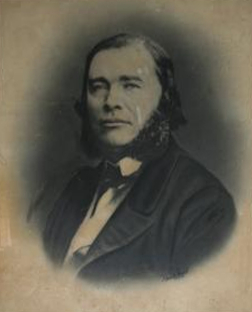John Allan Broun facts for kids
Quick facts for kids
John Allan Broun
|
|
|---|---|
 |
|
| Born | 21 September 1817 |
| Died | 22 November 1879 (aged 62) |
| Nationality | Scottish |
| Known for | meteorologist |
| Awards | FRS Royal Medal (1878) Keith Medal (1859-61) |
John Allan Broun (born September 21, 1817 – died November 22, 1879) was a Scottish scientist. He was very interested in the Earth's magnetism and in studying weather patterns, which is called meteorology.
Broun studied at Edinburgh University in Scotland. He worked at an observatory in Makerstoun from 1842 to 1849. After that, he moved to India to work in the Kingdom of Travancore. In India, he continued his studies on Earth's magnetism. He also helped set up new observatories there. One of his biggest discoveries was that the Earth's magnetic strength changes everywhere at once, not just in one small area. He also found that activity on the Sun causes changes in the Earth's magnetic field.
Early Life and Studies
John Allan Broun was born in Dumfries, Scotland. His father ran a school there. Broun went to Edinburgh University for his education. He was greatly inspired by his teacher, James David Forbes.
In 1842, people were very interested in studying magnetism. Thomas Brisbane set up an observatory at his home in Makerstoun, Scotland. Forbes suggested Broun to be the director, and Broun worked there from 1842 to 1849. He made many important observations about magnetism. These findings were later published in scientific papers. Broun sometimes had health issues, possibly from working long hours. He then hired an assistant named John Welsh. In 1850, he moved to Paris and got married. In 1851, he was asked to work in India.
Working in India
Starting in 1852, Broun became the director of the Trivandrum Observatory. This observatory was in Trivandrum, which was then part of the Kingdom of Travancore in India. Today, Trivandrum is known as Thiruvananthapuram. It is the capital city of the Indian state of Kerala.
The observatory had been started in 1836 by Swathi Thirunal Rama Varma, the Maharajah (ruler) of Travancore. Broun was sent to study geomagnetism, which is the Earth's magnetism. At that time, the British Academy wanted to study it all over the world. Trivandrum was a good place for this because it was very close to where the magnetic equator was located.
Broun noticed big changes in air pressure across India. He also saw regular changes in the Earth's magnetic field. He had local assistants in Kerala, including J. Kochukunju and E. Kochiravi Pillai. In 1853, while still in India, Broun was chosen to be a Fellow of the Royal Society of London. This is a very high honor for scientists.
He also built another observatory on Agastya Mala, the highest mountain peak in Travancore. He helped to start a museum and a zoo there too. The museum he helped create was later replaced by what is now called the Napier Museum. The zoo he helped start is still open today as the Trivandrum Zoo. Broun faced some health problems in India, including deafness. He returned to Europe in 1860, but then came back to India for three more years.
Later Career and Awards
Broun left India for good around 1865. He lived in Lausanne, Switzerland, and then Stuttgart, Germany. In 1873, he moved to London, England. With money from the Royal Society, he worked on studying the magnetic observations made at different places around the world. He also published important reports about his work at the Makerstoun and Trivandrum observatories.
For his more than 35 years of work on magnetism and meteorology, he received two major awards in 1878. He was given the Keith Medal from the Royal Society of Edinburgh. He also received the Royal Medal from the Royal Society in London.


